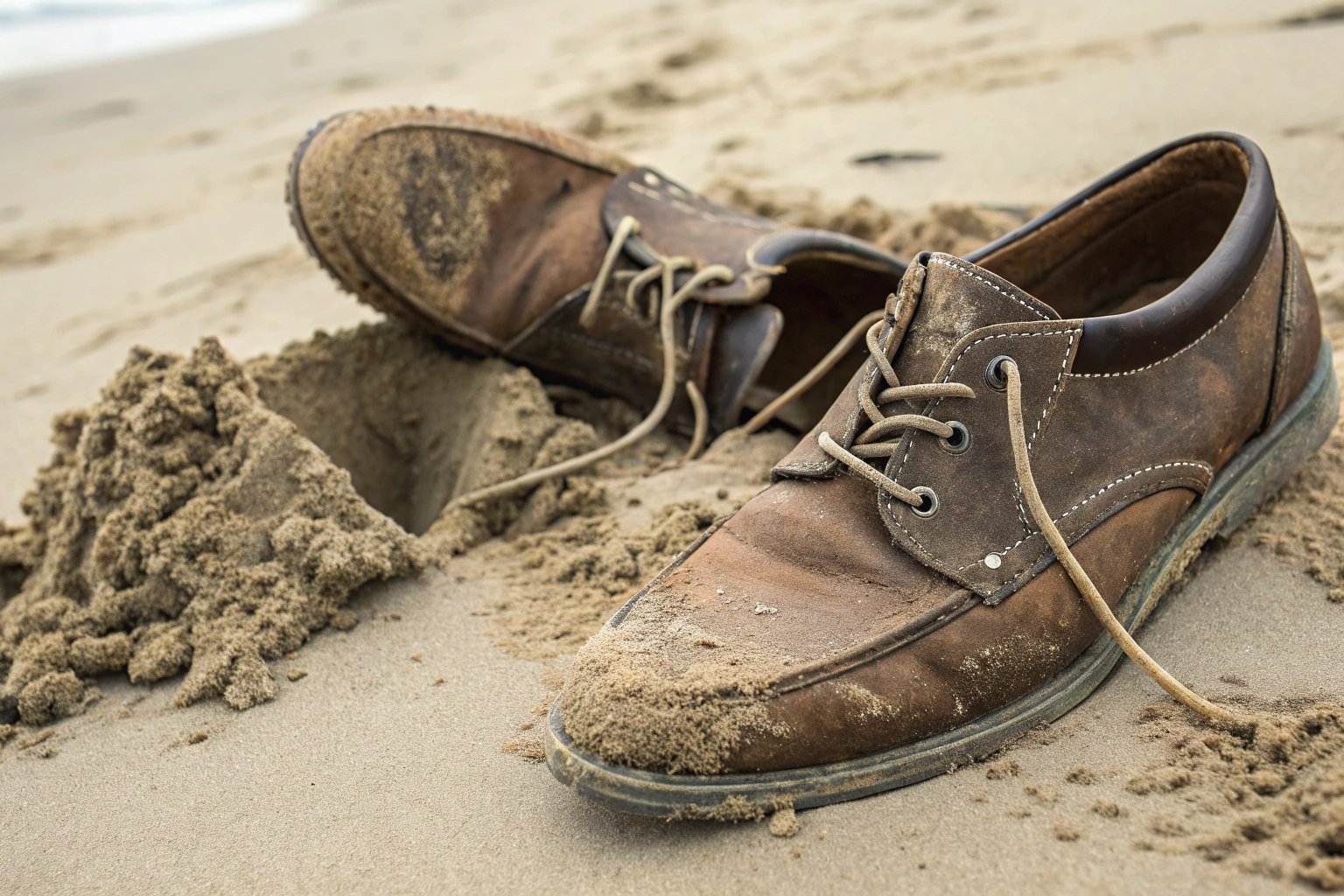Are you dreaming of a beach day? But worried about your favorite leather slippers? Don’t let footwear questions ruin your fun.
It’s generally not recommended to wear leather slippers to the beach because saltwater, sand, and sun can damage the leather. Choose water-resistant materials instead.

Let’s explore what happens to leather at the beach. And look at better options for your feet.
Can I wear slippers to the beach?
Worried about ruining your nice slippers at the beach? Beach footwear can be tricky. You want to be comfortable and stylish.
Slippers are generally suitable for the beach, but the material matters. Opt for waterproof or water-resistant materials like rubber, EVA, or synthetic fabrics. Avoid leather, suede, and other delicate materials that can be damaged by water and sand.

I remember a time when I wore my favorite suede slippers to the beach. Big mistake! They got soaked and filled with sand. It took days to clean them, and they never looked the same. I learned my lesson: beach slippers need to be durable and water-friendly.
Think about what your beach day will look like. If you plan to stay mostly on the sand, a basic pair of rubber or EVA slippers will do. These are easy to clean and quick to dry. If you’re going to be in the water a lot, consider water shoes or sandals designed for aquatic activities. These will provide better grip and protection for your feet. And don’t forget about the hot sand! Dark-colored slippers can get very hot in the sun, so choose lighter colors to keep your feet cool. EVA plastic slippers are good choice, because they are cheap.
Also, think about the style of slipper. Flip-flops are a classic choice, but they can be difficult to walk in if you’re going for a long walk on the sand. Slides are a good option if you want something easy to slip on and off. If you want more support, look for slippers with a contoured footbed and adjustable straps.
Can you wear leather sandals to the beach?
Thinking of wearing your leather sandals to the beach? Leather sandals look great. But can they handle sand and surf?
It’s best to avoid wearing leather sandals to the beach. Saltwater can stain and damage leather, and sand can scratch the surface. Repeated exposure can cause the leather to crack and deteriorate.

I’ve seen so many people ruin their nice leather sandals at the beach. The combination of sun, sand, and saltwater is just too harsh for the material. The leather can dry out, crack, and even change color. And once leather is damaged by saltwater, it’s very difficult to repair. That time I wear my leather sandals to the beach, I have to clean them for whole day, and it really makes me tired.
If you really want to wear sandals to the beach, choose a pair made from water-resistant materials like rubber, EVA, or synthetic fabrics. These materials are much more durable and can withstand the elements. Look for sandals with good traction to prevent slips on wet surfaces. And make sure they’re comfortable enough to walk in on the sand.
Here’s a comparison table that details why avoid leather and what options available:
| Material | Water Resistance | Durability | Comfort | Style | Best For |
|---|---|---|---|---|---|
| Leather | Low | Moderate | High | Stylish | Casual wear (not beach) |
| Rubber | High | High | Moderate | Basic | Water activities, easy cleaning |
| EVA | High | Moderate | Moderate | Versatile | Lightweight, affordable |
| Synthetic Fabrics | Moderate | Moderate | High | Varied | Quick-drying, various designs |
Consider the consequences before you wear leather sandals on the beach. There is alternatives which offers better protection for your feet and your wallet.
Is leather good for the beach?
Do you think leather is a good choice for beach wear? This is an important question to consider. Let’s see.
Leather is generally not suitable for the beach. Saltwater can damage and stain the material. Sand can cause scratches, and the sun can dry it out, leading to cracking and deterioration.

Back in college, I had a nice leather bag that I took to the beach. By the end of the day, it was covered in sand and saltwater. The leather became stiff and discolored, and it never looked the same. It was a costly mistake.
The beach is a harsh environment for leather. Saltwater is very corrosive and can break down the fibers in the leather. Sand acts like sandpaper, scratching the surface and causing wear and tear. And the sun’s UV rays can dry out the leather, making it brittle and prone to cracking. If you must bring leather items to the beach, keep them in a shaded area. Also, keep them away from the water and sand.
There are many other materials that are much better suited for the beach. Rubber, EVA, and synthetic fabrics are all water-resistant and durable. These materials can withstand the elements and are easy to clean.
Will sand ruin leather shoes?
Wondering if a day at the beach will destroy your leather shoes? It’s a valid concern for shoe lovers.
Yes, sand can damage leather shoes. The abrasive nature of sand can scratch and wear down the leather’s surface. It can also get trapped in the seams and lining, causing further damage over time.

I once wore my favorite leather boots to a beach bonfire. It seemed like a good idea at the time, but I quickly regretted it. The sand got everywhere, and it was impossible to get it all out. The leather became scratched and dull, and the boots never looked the same. Now I take better care of my leather boots and keep them far away from any kind of sand.
If you accidentally get sand on your leather shoes, it’s important to clean them as soon as possible. Use a soft brush to remove loose sand. Then, use a damp cloth to wipe away any remaining dirt. Allow the shoes to air dry completely before storing them. And don’t forget to condition the leather regularly to keep it supple and prevent cracking.
Even with proper care, repeated exposure to sand can still damage leather shoes. If you plan to spend a lot of time at the beach, it’s best to invest in a pair of shoes made from water-resistant and durable materials like rubber, EVA, or synthetic fabrics.
Conclusion
Avoid leather slippers at the beach. Instead, choose water-resistant options to protect your feet and footwear.

